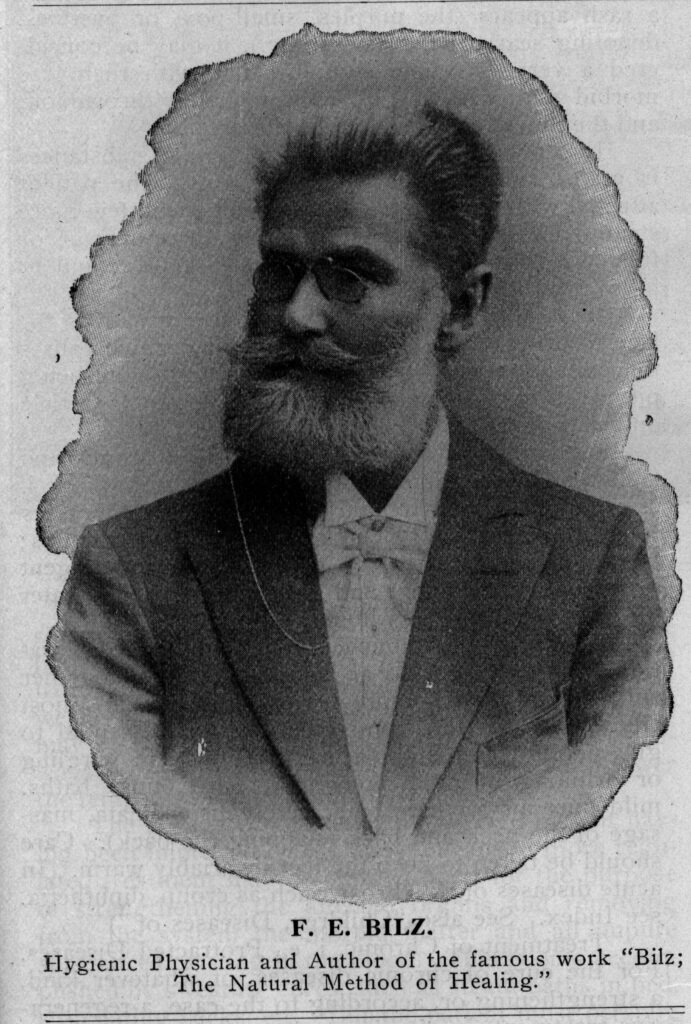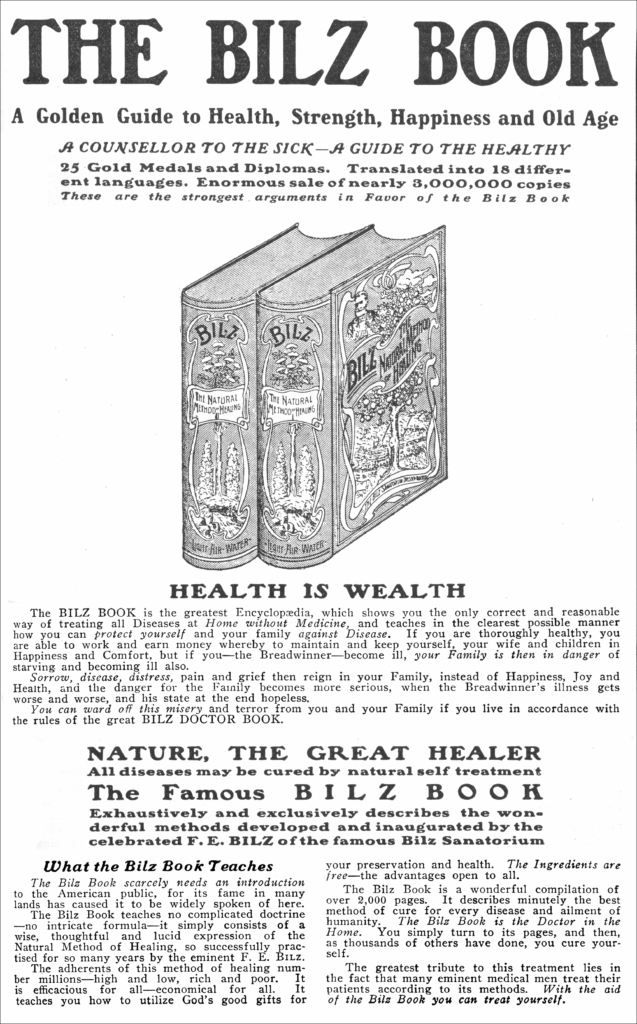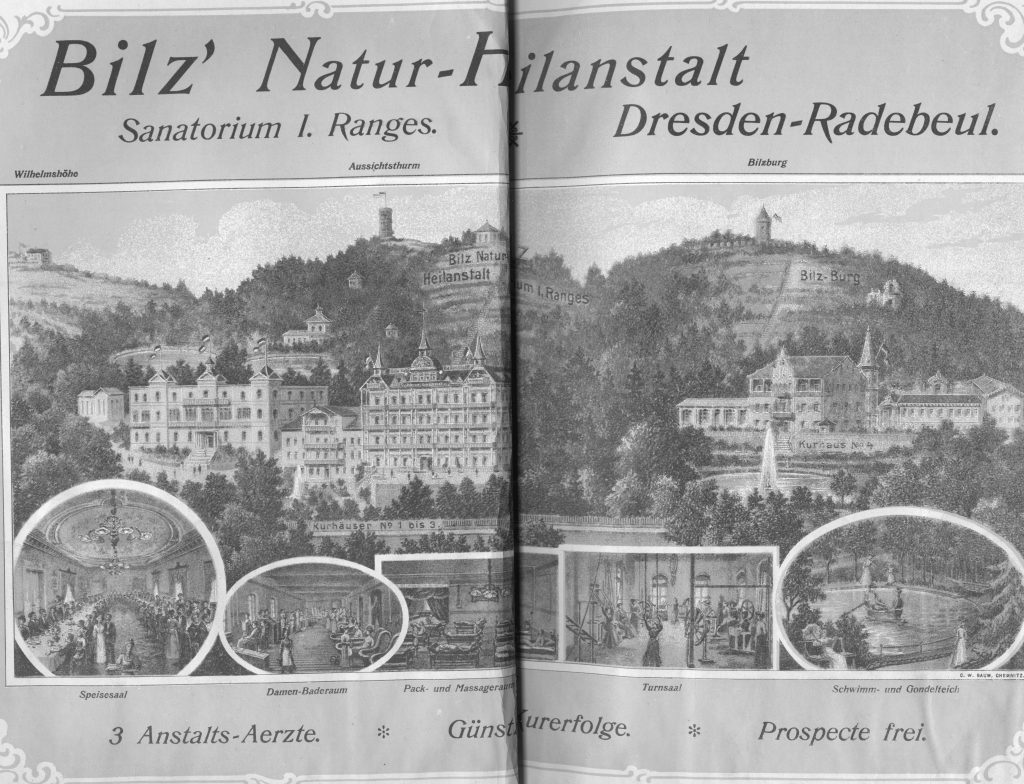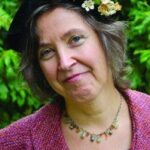Nature Cure Clinical Pearls
Sussanna Czeranko, ND, BBE
It is Nature that cures, not we. ~ Friedrich E. Bilz, 1898, p.6
Our only task then is to aid this vital power, and the subject of this present work is to thoroughly teach how it may be done. ~ Friedrich E. Bilz, 1898, p.6
Your book deserves more than any other to be translated into every living language. It is a masterpiece, and supplies all humanity with that of which was most in need. ~ Dr von Gotthard, 1905, p.302
Friedrich Bilz’s contributions to the natural health movement in Europe were huge. His foundational work in Naturopathic Medicine is respected among contemporary naturopathic doctors because of its prescience, its sheer volume, and excellence of content and completeness. Bilz feels familiar and important to us all these years later. Everything about Bilz also feels and looks big: the books that he wrote, the health sanitarium that he owned and operated, and his comprehension of what was needed to promote health for everyone. Benedict Lust wrote of Bilz, “Dr. Bilz is known wherever Nature Cure or Naturopathy is known as one of the early pioneers in our great movement.” (Lust, 1922, p.557)
I first learned of Bilz from his writings in the abundant Benedict Lust publications, many of which were included in the Hevert Collection. Then I discovered his encyclopedic book set, which is not only impressive in volume, but especially remarkable because of its rich content.
Figure 1. Friedrich Bilz; 1901

Bilz’s Literary Success
Bilz began as a weaver, in fact. In early life he experienced dreadful working conditions, and resulting health problems led him to explore all the available avenues to regain health. He left his factory job and established a grocery. Researching and restoring his health ignited his fertile intellect and resulted in his publishing massively successful books. With the proceeds from book sales and his lucrative grocery business, he moved to Radebeul, Saxony, to begin a spa. In 1888, Bilz published a 2-volume set of books in German (Das Neue Naturheilverfahren), and in 1898 The Natural Method of Healing, collectively totaling 2046 pages. These were translated into English and many other languages – a colossal publication landmark at the time (no Google search engine or “spell check” to transcribe a manuscript were available, also no electronic databases to coordinate the enormous research framework of Bilz’s massive work).
Bilz took 5 years to research and write his masterpiece. The Natural Method of Healing provided a substantial, articulate foundation for those interested in acquiring health within its pages. Before coming to the shores of America, Bilz’s books had essentially gone viral in many countries in Europe and beyond. Lust reported, “It has been translated into 52 languages, while the German language editions have already reached the 132nd edition.” (Lust, 1922, p.557) The books were translated into English and spread rapidly to every nook and cranny in the English-speaking world. In the promotional pamphlet enclosed in this set, one reads: “The Bilz Book is the greatest Encyclopedia, which shows you the only correct and reasonable way of treating all Disease at Home without Medicine.” (Bilz, 1898, pamphlet) At the time of this printing of the 1898 English versions of his books, “Three million copies sold. It appeals to everyone taking an interest in his health and strength.” (Bilz, 1898, pamphlet)
Figure 2. Ad for The Bilz Book; 1901

Influenced by his mentor, Father Kneipp, who worked throughout his life administering and teaching water cure to the poor and those unable to afford health care, Bilz also believed in health sovereignty. Wanting people to be self-sufficient in treating their illnesses, Bilz writes, “The method of treating disease must be so simple as to be comprehensible to anyone of average intelligence.” (Bilz, 1901, p.213) Bilz quickly adds that there is no treatment that can be used for all diseases, and so learning and studying were needed in order to differentiate for individualized care. Although Bilz’s books were intended for the lay reader, to guide his or her way to health, the importance and reach of these publications went far beyond. Many people who read his books were actively pursuing careers in natural health, and these books provided a solid foundation for their studies and their professional pursuits. One such admirer, Dr von Gotthard, an accomplished medical doctor, wrote a letter to Bilz validating and celebrating Bilz’s intentions: “Your work The Natural Method of Healing is comprehensive and yet so concise, so exact and yet so clear as to be easily understood by everybody, and is a veritable gospel of health and of the new science of healing, and should find a place in every household.” (von Gotthard, 1905, p.302)
It is unbelievable how much information Bilz packs into the pages of his book, right from the first page. The “Preface” zeroes right in on the purpose of his books. He writes,
The more, however, I studied the rules of the laws of Nature, and the more I followed them, the more was the painful conviction forced upon me that mankind of today is struck with blindness when it is a question of protecting oneself from sickness or of healing oneself of such ailments as have been systematically contracted. (Bilz, 1898, p.iii)
Vitality & the Laws of Nature
Perplexed that so few paid attention to their health, Bilz asked the timeless question that almost every naturopathic doctor today asks when witnessing the blind, almost knee-jerk responses of patients choosing conventional medicine: “Why is the natural method of healing regarded with so little attention and consideration by the people?” (Bilz, 1898, p.iii) His response:
Merely because its laws are too simple. For with the simple prescription of diet, water, air and light, the natural healer cures all diseases, of whatever standing, provided they are curable; for this method of treatment requires that there should be sufficient vitality of the body to enable a reaction to follow and the crisis to be got over.” (Bilz, 1898, p.iii)
In the previous statements, Bilz introduced some consistent messages that the early Naturopaths reiterated over and over. First, the laws of Nature govern health; second, the means of healing includes diet, water, air, and light; and third, if the body has enough vitality to mount a reaction to the natural treatments, the resulting curative crisis will restore health.
Father Sebastian Kneipp had made a huge impression upon Bilz, and throughout Bilz’s writings, the quiet voice of Kneipp comes filtering through. Kneipp had written small tomes on water cure a decade prior to Bilz’s foundational books. Bilz built upon Kneipp’s work and expanded it to be fully comprehensive. He included exceptionally well-designed anatomical diagrams and cut-outs, and organized his book alphabetically to address all known diseases and various therapeutic options, such as gymnastics, Swedish movement, massage, hypnotism, magnetism, electricity, etc. The Kneipp Cure dominated the work of Bilz. In this regard, Bilz excelled at outlining in a concise and systematic manner the essentials of Kneipp’s work.
In the first chapter, in just 7 pages, Bilz presents 26 elements of the general principles of the natural method of healing. Most of these are recognized as belonging to Kneipp, but Bilz also included the various other modalities found during his search for health.
The first and sixth principles outline the essential need for patients to be warm before, during, and after undertaking a water cure. Bilz writes, “During a water treatment in any form, the body, and more particularly the feet, must be sufficiently warm; the patient should never be treated when he feels chilly.” (Bilz, 1898, p.1)
As one reads through Bilz’s introduction to the principles of Natural Methods of Healing, it is clear where the early Naturopaths found the basis of Naturopathy. The writings of Bilz were assimilated, modified to a certain extent, and became the principles of the early pioneers of Naturopathy. Benedict Lust would consult Bilz’s books, to help him write his own articles for his publications. Bilz was respectful of Kneipp, adding extensively to Kneipp’s armamentarium.
Bilz’s books were considered as some of the best available to those practicing natural healing. Dr Katz, Medical Staff Officer, contributed a testimonial about Bilz’s work to Lust’s magazine in 1905: “I consider [the] book, The Natural Method of Healing by far the best work on the subject of Natural Healing, and recommend it as the most complete and comprehensive existing.” (Katz, 1905, p.302) Dr von Gotthard writes, “I, a medical practitioner of 45 years of experience in both hemispheres, can testify to the great blessing you have conferred on humanity by the publication of this gigantic work which gives undeniable proof of untiring labor and extensive valuable knowledge.” (von Gotthard, 1905, p.302)
The Birthing of Naturopathy
Bilz established a health sanitarium at Radebeul–Dresden in Saxony in 1895, which spanned 4 large palatial buildings – a facility not equaled since. Bilz’s sanitarium was the largest in the world at that time. He invented a wave pool in 1901 and established the first light and air bath for the masses. (Lust, 1922, p.557)
Figure 3. Bilz Sanitarium; 1902

Bilz’s “Preface,” in the English edition for America, was distributed shortly afterwards by the International News Company of New York. In this 1901 edition, Lust appears, previewing for us his own aspirations. At the end of Bilz’s books are 16 pages of advertisements. A few American hydropathic physicians and health product businesses placed ads; however, the majority of the ads belonged to Benedict Lust promoting his store, Kneipp Health Store, and his academic schools. Lust occupied 13 of the 16 pages, which were devoted to his Kneipp Store in New York City.
The Kneipp Store was the first of Lust’s locations in New York City – 111 East 59th Street. This address was the site for the publishing endeavors as well as for the store that sold Kneipp herbs, bread, clothing, books, and health food. Lust was not the first to open up a health food store in America, but probably one of the first to include Kneipp and other merchandise in his offerings, such as Bilz’s products.
Benedict Lust placed 2 half-page ads on the same page promoting the New York Naturopathic Institute and Lust & Regeniter’s Naturopathic College. The Institute was a clinic offering “radical cures by the latest natural healing methods.” (Lust’s ad in Bilz book) The therapies employed included: hydrotherapy, internal massage (Thure-Brandt), German and Swedish movement and gymnastics, light, air, and sun baths, diet, electro-therapies, mental culture, psychotherapy, osteopathy and more. With these offerings at his clinic, we can see the influence of Bilz and the many therapeutics that were part of his books and his sanitarium. Between Fr Regeniter and Lust, the clinic was open every day of the week, so robust did they anticipate demand to be.
The ad for the naturopathic college looks to be one of the first published for Naturopathy. Benedict Lust partnered with Fr Regeniter. Of note is that other than his name in these ads, I have not found any writings made by Lust’s first partner in these naturopathic endeavors. Fr Regeniter entered and exited the naturopathic development quite quickly, it seems.
The Naturopathic School and Clinic were at Lust’s second location in New York, very near to his first office, at 135 East 58th St. What is interesting about these ads is the use of “Naturopathic Physician” as the title adopted by Lust and Regeniter. The appearance of these titles in these early books of Bilz indicates that Lust was already putting into motion the creation of Naturopathy and saw Bilz’ work as an exceptional catalyst for that vision. It is as if we are witnessing the transition from Kneipp Water Cure to something entirely new, but not yet shaped and formed. Regeniter was a professor at the Naturopathic College, and Lust described himself as a naturopathic physician and the editor of his publications.
Bilz’s The Natural Method of Healing ensured that the work of Kneipp would be perpetuated as a foundation for the emerging naturopathic profession. His content provided much to the curriculums for the early Naturopaths. Bilz had expanded upon Kneipp’s work, and included new therapeutic modalities that Lust adopted in his own school. Bilz was an important foundation stone for Naturopathy and helped shape its direction from Water Cure, to include a multi-disciplinary approach to natural health care.
In the end, Benedict Lust wrote an obituary for the esteemed Friedrich Bilz: “Someday, when the history of the Nature Cure movement is written, the name of Bilz will be given a very prominent place on its pages. Naturopaths, everywhere, mourn the death of this great leader in Nature Cure and Natural living.” (Lust, 1922, p.557) We have much to be thankful for. Friedrich Bilz brought the change needed to help create the diversity that Naturopathy came to embrace.
References:
Bilz, F. E. (1898). The Natural Method of Healing. Leipzig, Germany: F. E. Bilz.
Bilz, F. E. (1901). Modes of Application. The Kneipp Water Cure Monthly, II (8), 213-217.
Katz, Dr. (1905). Testimonials from Medical Men with regard to Bilz, Natural Method of Healing. In: The Naturopath and Herald of Health, VI (11), 302.
Lust, B. (1922). Naturopathic News. Herald of Health and Naturopath, XXVII (11), 557.
von Gotthard. (1905). Testimonials from Medical Men with regard to Bilz, Natural Method of Healing. In: The Naturopath and Herald of Health, VI (11), 302.
 Sussanna Czeranko, ND, BBE, graduated from CCNM in 1994; she has since developed and refined an extensive repertoire of nature-cure tools for her patients. Cofounder and previous Co-chair of ICNM, Dr Czeranko is strongly committed to professional formation. She has been an NDNR monthly contributing editor for over a decade, and a contributing author to the Foundations of Naturopathic Medicine project. As Curator of NUNM’s archival collection, she recently completed the 12-volume Hevert Collection, published by NUNM Press. Dr Czeranko founded The Breathing Academy, which trains NDs in the breathing therapy, Buteyko. She also developed the naturopathic medical spa, Manitou Waters, scheduled to open in Fall of 2019. This unique clinical and education centre is located on the shores of a pristine, magical saline lake at Manitou Beach, Saskatchewan.
Sussanna Czeranko, ND, BBE, graduated from CCNM in 1994; she has since developed and refined an extensive repertoire of nature-cure tools for her patients. Cofounder and previous Co-chair of ICNM, Dr Czeranko is strongly committed to professional formation. She has been an NDNR monthly contributing editor for over a decade, and a contributing author to the Foundations of Naturopathic Medicine project. As Curator of NUNM’s archival collection, she recently completed the 12-volume Hevert Collection, published by NUNM Press. Dr Czeranko founded The Breathing Academy, which trains NDs in the breathing therapy, Buteyko. She also developed the naturopathic medical spa, Manitou Waters, scheduled to open in Fall of 2019. This unique clinical and education centre is located on the shores of a pristine, magical saline lake at Manitou Beach, Saskatchewan.





